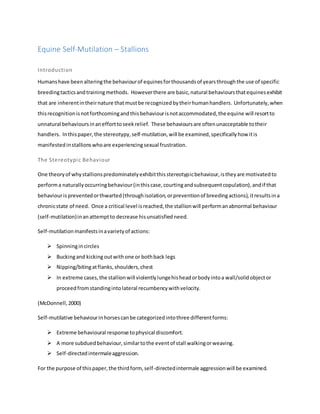
equinebehaviourpaper
- 1. Equine Self-Mutilation – Stallions Introduction Humanshave beenalteringthe behaviourof equinesforthousandsof yearsthroughthe use of specific breedingtacticsandtrainingmethods. Howeverthere are basic,natural behavioursthatequinesexhibit that are inherentintheirnature thatmustbe recognizedbytheirhumanhandlers. Unfortunately,when thisrecognitionisnotforthcomingandthisbehaviourisnotaccommodated,the equine will resortto unnatural behavioursinanefforttoseekrelief. These behavioursare oftenunacceptable totheir handlers. Inthispaper,the stereotypy,self-mutilation,will be examined,specificallyhow itis manifestedinstallionswhoare experiencingsexual frustration. The Stereotypic Behaviour One theoryof whystallionspredominatelyexhibitthisstereotypicbehaviour,istheyare motivatedto performa naturallyoccurringbehaviour(inthiscase,courtingandsubsequentcopulation),andif that behaviourispreventedorthwarted(throughisolation,orpreventionof breedingactions),itresultsina chronicstate of need. Once a critical level isreached,the stallionwill performanabnormal behaviour (self-mutilation)inan attemptto decrease hisunsatisfied need. Self-mutilationmanifestsinavarietyof actions: Spinningincircles Buckingand kicking outwithone or bothback legs Nipping/bitingatflanks,shoulders,chest In extreme cases,the stallionwill violentlylungehisheadorbodyintoa wall/solidobjector proceedfromstandingintolateral recumbencywithvelocity. (McDonnell,2000) Self-mutilative behaviourinhorsescanbe categorizedintothree differentforms: Extreme behavioural response tophysical discomfort. A more subduedbehaviour,similartothe eventof stall walkingorweaving. Self-directedintermaleaggression. For the purpose of thispaper,the thirdform, self-directedintermale aggressionwill be examined.
- 2. The Crisis of the Natural Behaviour In free roamingbandsof horses,the bandstallionservesseveralfunctions;he drivesthe bandfromthe rear, protectsthe band from predationandprocreates. Whentwostallionsfromdifferentbandsmeet, variousbehavioursare exhibited,including:investigationof the flankareas,scentingof the bodyand nippingof the genital andflank. Thismeetingisusuallyaccompaniedwithvocalizations(squealing), kicking,andspinningincircles. However,whenastallionisisolatedfromother“bandmembers”during the breedingseason,thisbehavioursare turneduponhimself. Thisbehaviour,exhibitedinastate of isolation,mayalso be heighteneduponthe investigationof studpiles, bodyoil residue leftinpaddocks that may have beenpreviouslyusedbyanotherstallion,andscentsof maresinestrous. The developmentof thisbehaviourislessacute thanthe otherformsand can beginas earlyas pubertyor intothe teens. “It typicallycontinuesforthe life of the stallion.”(McDonnell,2000). Managing Self-Directed Intermale Aggression As withanystereotypicbehaviour,athoroughveterinariancheckup-upshouldbe firstonthe listto determine if there isaphysical reasonforthisbehaviour. Generally,if the stallionhashadhisbehaviour labelledasself-directedintermale aggression,anyphysical maladyhasalreadybeenacknowledgedand ruledout. Notall of the management tacticssuggestedbelow have successful outcomes,whatmayworkforone stallion,maynotworkfor another. These managementtacticsare not listedinanyorderof success: 1. Pharmacologicaids-generallymedicationsare usedinconjunctionwithother management changes,notas a stand-alone solution. Examplesof pharmacologicaidsinclude longterm tranquilizers,tricyclicanti-depressantssuchasimipramineandclomipramine,progesterone and 1-tryptophan.(McDonnell,2000). 2. Gelding-notalwaysa viable tacticforvaluable breedingstallions. There have beencasesin whichthe behaviourdisappears,howeveralsosituationsinwhichthe behaviourworsens. 3. Physicalrestraint-notconsideredalongtermmanagementsolutionasitdoesnotaddress the stereotypy,itonlypreventsfurtherinjurytothe stallionwhile optionsare being considered. Restraintsmayinclude neckcradles,grazingmuzzles,bibsandblankets. Itis importantto understandthatthistype of self-mutilationiscausedbyfrustration,the stallionispreventedfromexhibitednatural behaviours,thusthisdrive hasmanifestedinto
- 3. an abhorrentbehaviour. Byrestrainingthe stallion,the handlerisfurtherpreventingcoping behaviourandadditional stereotypieswill manifest. 4. Distractions (social,work,nutrition)-considered one of the mosteffectivemanagement solutionforthisbehaviouristoprovide a distractionoran “outlet”. Oftencausedby inappropriate management,stallionsare commonlyisolateddue totheirhighenergy nature. By turningthe stallionoutintoa more appropriate environmentthatincludesa large pasture and a small groupingof mares,a social distractioniscreated. Now the stallion has purpose andresponsibility. Howeverthismanagementpractice maynotbe feasibleforthe performance stallion. Other social companionshipsmaybe consideredsuchasotherspecies. Examplesincludedonkeys, goats andchickens. “…chickensasstall companionsforself-mutilators,itseemsthatthe horse sometimesisreluctantto move aroundthe stall,lestitcause the chickentoscurry and flutter. Some stallionsalsoseemdistractedbytheirefforttoavoidsteppingonthe chicken.”(McDonnell,2000) An all forages dietoftenprovidessignificantchangesinbehaviour. Asconcentratesintheir manufacturedformisnotpart of a natural equine diet,there have beenindicationsthat excessiveconcentratesproduce alteredbrainfunction. Alteredbrainfunctionshave been identifiedaskeycomponentsinthe developmentof stereotypicbehaviours. There are othermanagementtacticsthatbearmentionaswell. Oftenself-directedintermale aggressionsessionsare provokedbythe presence of otherstallionscentsandfeces. Simplesolutions such as applyingascentmaskerto the nose, frequentbathingandremoval of fecesfromthe livingareas may be used. Anothermanagementtacticthathas experiencedextensivesuccessinrehabilitatingstallionswhoare self-mutilatingishousingthe stallioninatie stall. Currentlythere are nostudiesonthe use of tie-stalls and thisstereotypy,however“….recentworkwithtie-stalledhorsesinthe PMUindustryhasindicated that abnormal behaviouringeneral isverylow intie-stalledhorsescomparedtobox stalledhorses”. (McDonnell,2000). It’simportantto reiterate thatitmay take careful applicationof several of these tacticstoproduce a desiredresult. Itmay take a combinationof tacticsor one simple change. Stallionsare individualsand each will responddifferentlytothe above mentionedmanagementchanges.
- 4. Conclusion The science behindall three formsof self-mutilationisnota well-knownone. Itpresentsanespecially complicated scenarioasthe behaviourmaybe causedbyphysical orpsychological issues. There isno effective,concrete cure forself-directedintermale aggressive self-mutilation.Instead,itissuggested that managementof stallionbe examined,changesmade,andcurrent,on-goingcare be administeredto lessenthe chance of potential seriousinjury.
- 5. References: McDonnell,Sue,PhD.March 1, 2000. “Equine Self Mutilation”. Accessedat: www.thehorse.com/print- article/12622. Accessedon:March 8, 2015. McDonnell,Sue,PhD. 1999. “StallionSexualBehaviour”. Accessedat: research.vet.upenn.edu/Portals/49/00StalliU.pdf. AccessedonMarch11, 2015. Sappington,Brenda,PhD.2001. “Hormonesand Horse Behaviour”.Accessedat: http://www.horsechannel.com/horse-breeds/hormone-horse-behavior-1168.aspx. Accessedon:March 15, 2015. Shuster,Louis,PhD.etal. 2007. “Pharmacological Treatmentof Equine SelfMutilationSyndrome”. Accessedat:www.jarvm.com/articles/Vol2Iss2/DODMANJARVMVol2No2.pdf. AccessedonMarch 10, 2015.